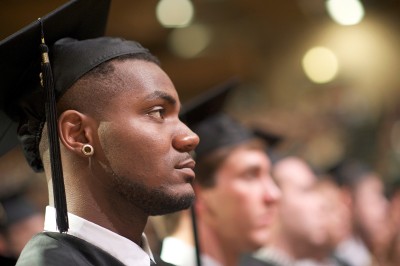A word rarely uttered on college tours sits atop the website of St. Olaf, a small liberal-arts college south of Minneapolis with an annual estimated cost of $51,860.
Next to clickable categories about arts and athletics appears the unlikely word “outcomes.’’
 And if you click on the word, a headline materializes promising “The Return on Investing in a St. Olaf Education.’’
And if you click on the word, a headline materializes promising “The Return on Investing in a St. Olaf Education.’’
A few more clicks and you can learn what becomes of graduates after four years on its sylvan campus along the Cannon River. For example: Where will a St. Olaf education lead? Then there is “What Happens After Graduation: Recent Alumni Data,’’ along with retention and graduation rates, and “evidence of learning.”
This new level of candor sounds like an answer to growing concerns of parents, politicians, and foundations concerned about the value for money of a higher education—and of students worried about finding jobs and repaying college loans.
And it’s part of a new wave in higher education.
Concerns that the rising costs are leaving too many behind are increasingly accompanied by fears that today’s college graduates lack sufficient workforce skills—or that they aren’t learning enough.
That contention is backed up by separate survey of employers, more than 40 percent of whom don’t think colleges are teaching students what they need to know to succeed. One third said graduates aren’t qualified for even entry-level work, as we reported in September.
Concerns about the economy, employment, and the role of liberal-arts colleges fueled St. Olaf’s decision to publish detailed employment and salary data beginning in 2012—to the applause of applicants and alumni—says its president, David Anderson.
“Parents love it,’’ says Anderson, who makes the case in a video posted on the site.
What St. Olaf shares “goes way beyond other colleges,’’ Anderson says, adding that he hopes more “will be equally transparent.”
St. Olaf’s move comes at a time when higher education is increasingly on the defensive, and as President Barack Obama is pushing to increase the college-going rates of low-income students in particular, who can’t even consider schools with price tags like St. Olaf’s without major discounts.
The question of what students of all kinds are learning from their college experience—and earning once they get out—is the one Anderson focused on at the annual meeting of the AAC&U, the Association of American Colleges and Universities, where tensions facing higher education were clear in session titles. One on the future of liberal arts carried an ominous question: “Preparing for the Apocalypse?”
 “We go to meetings, read articles and books, and listen to talks all dedicated to the assumption that higher education, as we know it, and particularly the liberal arts, is doomed,’’ wrote Jim Salvucci, dean of the School of Humanities and Social Sciences at Stevenson University in Maryland, in a blog published after the meeting. “One could hear solution-rich pragmatism amid the zeitgeist of sinking anxiety in many panels and presentations.’’
“We go to meetings, read articles and books, and listen to talks all dedicated to the assumption that higher education, as we know it, and particularly the liberal arts, is doomed,’’ wrote Jim Salvucci, dean of the School of Humanities and Social Sciences at Stevenson University in Maryland, in a blog published after the meeting. “One could hear solution-rich pragmatism amid the zeitgeist of sinking anxiety in many panels and presentations.’’
Colleges like St. Olaf are trying to get out ahead, as is the AAC&U through initiatives that champion the value of the liberal arts.
Bucknell University in Pennsylvania now publishes “learning outcomes’’ for every major. Wake Forest College in North Carolina promises “a standardized assessment of learning outcomes’’ for Chinese majors, among others, and has boosted its focus on preparing students for careers.
Increasingly, as The Hechinger Report reported this week, college students are being asked to take exit tests to determine what they learned—something many colleges and universities have resisted.
That’s one reason why Massachusetts is also trying to get out ahead of the trend. State Education Commissioner Richard M. Freeland will lead a group of nine states in developing a way to measure and compare what students learn in college without standardized tests, using class work, labs, and other measures.
“There is tremendous interest in this nationally, because everybody in higher education knows, if this doesn’t work, the next answer is a standardized test probably imposed by the federal government or by states,” Freeland said during a meeting of the state’s higher education board, according to the Boston Globe.
Freeland told The Globe that the project addresses a concern he had as President of Northeastern University from 1996 to 2006, where he would hand out thousands of degrees each spring.
“I’d be thinking to myself, ‘So what do they really know? What do I know about what they know?’ I always had to be honest and say to myself, ‘I don’t really know, and nobody else does either,’ ” he said.
Anderson, of St. Olaf, disagrees, and says his college’s new approach, which also includes far more robust career counseling, is an answer to skeptics.
“A liberal-arts degree gives you the knowledge base, skills, competencies and habits of mind that will enable you to flourish,’’ he says. “College can’t be a black box.”



